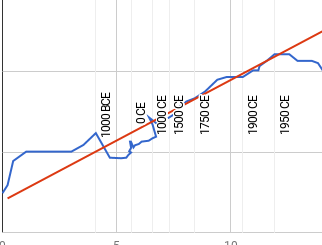We know of ten events which produced a robust discontinuity in progress equivalent to more than one hundred years at previous rates in some interesting metric. We know of 53 other events which produced smaller or less robust discontinuities.
Background
These cases were researched as part of our discontinuous progress investigation.
List of cases
Events causing large, robust discontinuities
- The Pyramid of Djoser, 2650BC (discontinuity in structure height trends)
- The SS Great Eastern, 1858 (discontinuity in ship size trends)
- The first telegraph, 1858 (discontinuity in speed of sending a 140 character message across the Atlantic Ocean)
- The second telegraph, 1866 (discontinuity in speed of sending a 140 character message across the Atlantic Ocean)
- The Paris Gun, 1918 (discontinuity in altitude reached by man-made means)
- The first non-stop transatlantic flight, in a modified WWI bomber, 1919 (discontinuity in both speed of passenger travel across the Atlantic Ocean and speed of military payload travel across the Atlantic Ocean)
- The George Washington Bridge, 1931 (discontinuity in longest bridge span)
- The first nuclear weapons, 1945 (discontinuity in relative effectiveness of explosives)
- The first ICBM, 1958 (discontinuity in average speed of military payload crossing the Atlantic Ocean)
- YBa2Cu3O7 as a superconductor, 1987 (discontinuity in warmest temperature of superconduction)
Events causing moderate, robust discontinuities
- HMS Warrior, 1860 (discontinuity in both Royal Navy ship tonnage and Royal Navy ship displacement)
- Eiffel Tower, 1889 (discontinuity in tallest existing freestanding structure height, and in other height trends non-robustly)
- Fairey Delta 2, 1956 (discontinuity in airspeed)
- Pellets shot into space, 1957, measured after one day of travel (discontinuity in altitude achieved by man-made means)1
- Burj Khalifa, 2009 (discontinuity in height of tallest building ever)
Non-robust discontinuities
This spreadsheet details all discontinuities found, as of April 2020.
- This was the first of various altitude records where the object continues to gain distance from Earth’s surface continuously over a long period. One could choose to treat these in different ways, and get different size of discontinuity numbers. Strictly, all altitude increases are continuous, so we are anyway implicitly looking at something like discontinuities in heights reached within some period. We somewhat arbitrarily chose to measure altitudes roughly every year, including one day in for the pellets, the only one where the very start mattered.



3 Trackbacks / Pingbacks
Comments are closed.